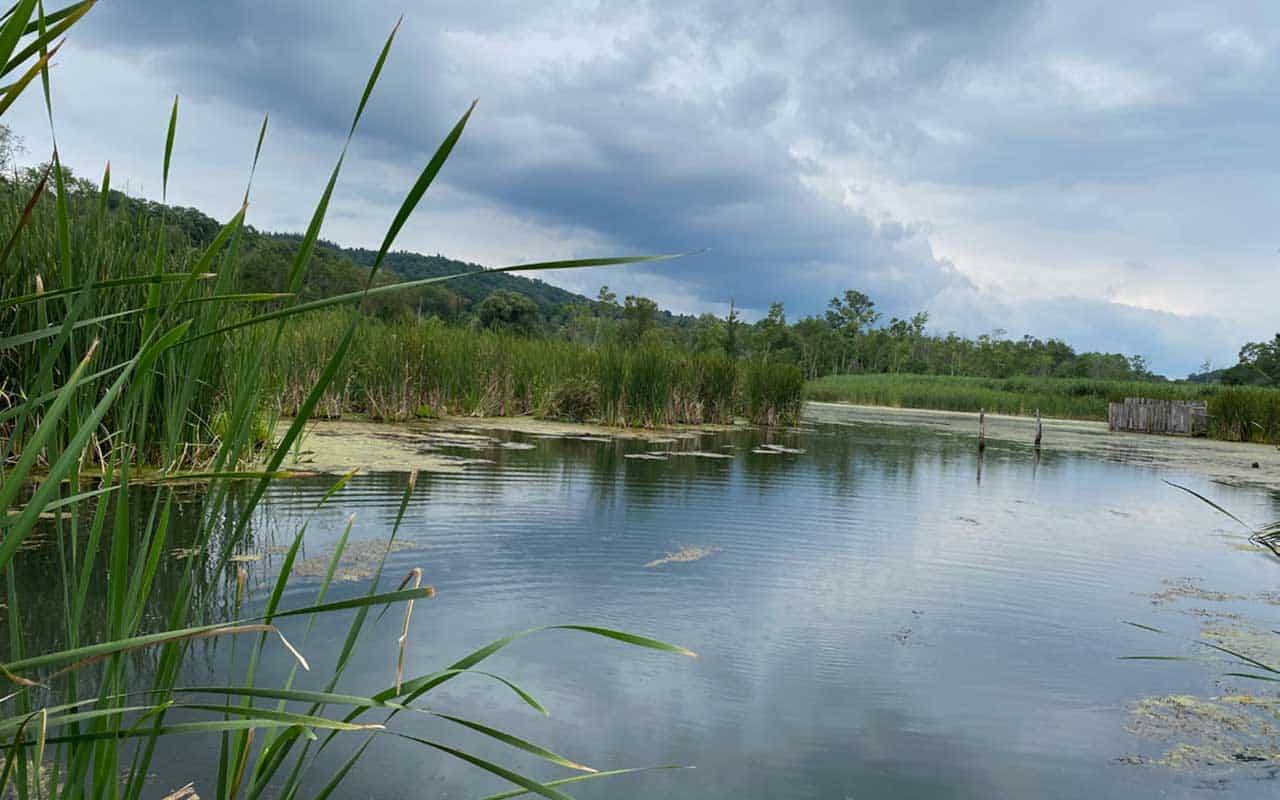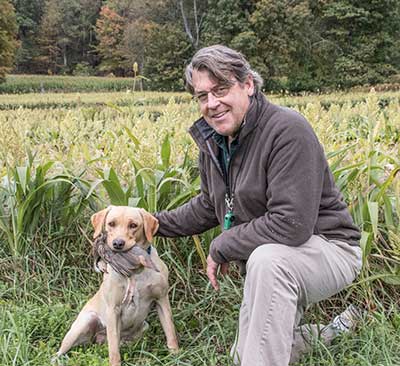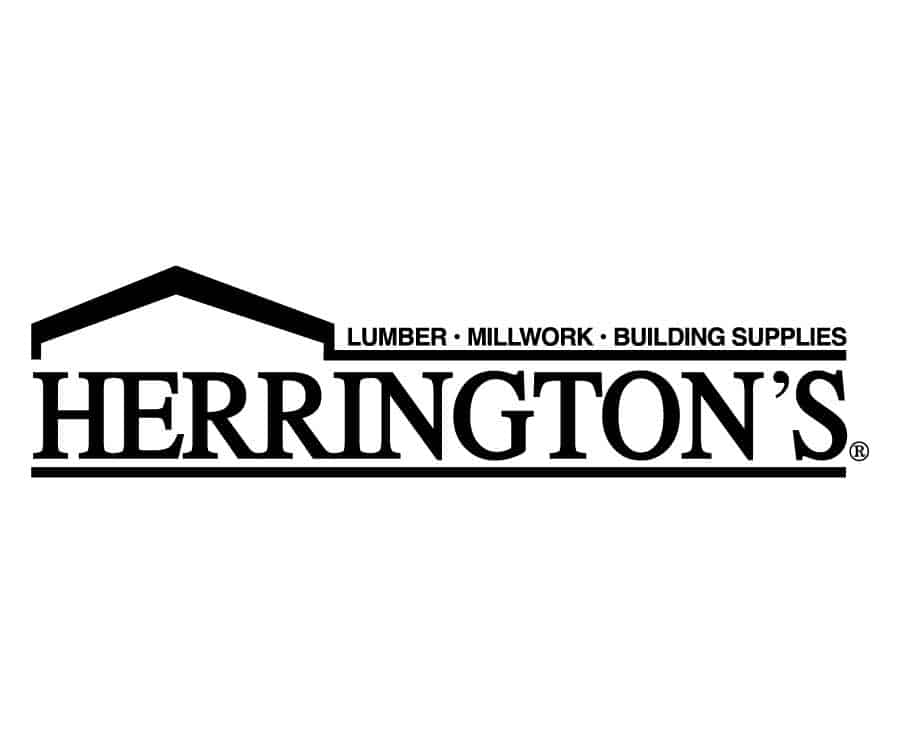Main Street Business

Keeping the Land
Before it started to rain and after the last Sunday lunch was served in the dining room, Tim Bontecou, President of Tamarack Preserve Ltd., took me for a SUV drive over the gravel roads and fields of the preserve, which have been in the Bontecou family since the late 1930s.
Starting out at the clubhouse and sporting clay stations, the narrow road followed the stream running through limestone canyons, and forests of hemlock and hardwood to the serene lakeside lodge. Another grassy trail led to the fishing ponds and fields planted with switch grass, corn and sorghum for the upland birds. Deer bounded in front of us. A heron took flight over the wetlands. The tranquility, beauty and variety of the natural landscape was inspiring.
How would you describe the Tamarack Preserve?
Tamarack is a non-proprietary private membership hunting and fishing club that we hope promotes good sportsmanship and a general love of the outdoors – plus some of the best food in the area. Within 30 miles of us there are many hunting clubs, but each one has their own little niche and flavor. I think we are a bit different in encouraging young people to become involved and being more informal than some other clubs. For example, here, if they wish, members can hunt with their own bird dogs.
 Why did you create Tamarack?
Why did you create Tamarack?
My family created this preserve on land the family has owned for three generations to protect 1,700 acres from development and to help defray the expenses of owning land. We began modestly in 1991 housed in a small, old farmhouse. After deciding the farmhouse was just too rotten to save, we built this new clubhouse with the restaurant, kitchen, bar, and library in 1994. Our simple goal in starting the preserve to hold onto and protect this land has remained unchanged. The hunting and fishing club was the solution to profitably using marginal land.
How did you decide on the name?
There was already a lake in the swamp called Lake Tamarack that just seemed like an obvious choice. The tamarack tree, also known as a larch, is a deciduous conifer whose needles turn a brilliant yellow in the fall. Preserve is in the name because that is our mission.
What was the most difficult thing when you first started?
The early years were rough. Attracting members before we had facilities wasn’t easy. But we had the land and that made everything possible.
How do you become a member?
Typically, a member brings you as a guest and then sponsors you if you decide to apply for membership. There are two levels of membership – an associate membership which allows you to shoot clays, fish, use the dining room and walk the property, and regular membership which includes all the foregoing plus hunting. There’s not a formal board review process, just management’s decision.
There’s a one-time initiation fee when you join that will not be refunded if you discontinue your membership. Then there are annual dues and usage fees. The idea is to keep dues low and let usage fees cover the costs of any activity. Our goal is to keep fees affordable and maintain and improve our facilities. Our annual member turn-over rate due to death, lack of interest, or relocation is minimal. We have limits on the number of members because we want to be able to provide top services when someone calls up to reserve a field or have dinner. In a way we are like a gym.
What do you offer members? Do you need a hunting license?
The preserve covers 1,050 acres on this side of Route 44 and then another 700 acres hidden across the road. There are eight separate hunting fields for birds, three areas for hillside release, a five stand and 15 stations for sporting clays, a rifle range for target practice and gun sighting, a swampy section for ducks, a bass pond, wild game areas for hunting deer, turkeys, ducks and geese, and the stream for trout fishing.
At the end of the preserve’s central road is a small lake which was created by the Thorne family who assembled this tract of land in 1905. They built the iron bridge over the stream and the 30’ high, 150’ long dam. There’s a historic lake side fishing lodge that members can utilize for entertaining and a rustic log cabin for camping. We stock the ponds with bass and the streams with trout, and release birds in the fields. About 80% of the fish are catch-and-release and lots of the birds escape the hunters. Guides with trained dogs, mostly labs and springer spaniels, are provided for field hunts. Instruction is available for anyone wanting to learn how to shoot and fish. In our pro shop, you can rent a shotgun or a fishing rod if you don’t have your own.
No licenses are required for upland bird hunting on the preserve; however, regular state permits and stamps are required for hunting wild game in season and, in most instances, for fishing.
It must be hard to keep this road open
The rainstorm two weeks ago really tore up the roads and we’re still working to repair them. We have dumped many loads of gravel from our own bed to restore them. Maintenance of our infrastructure demands a lot of equipment. The preserve owns four tractors, a skid steer, five pickup trucks, plus mowers, weedwhackers and chain saws, etc. There are about 12 miles of roads and trails to maintain plus all the buildings and structures.
How many employees do you have?
We have 30 full and part time employees. Many of our staff members have been here 15 to 18 years. I believe it’s a good place to work, but like all businesses today it’s hard to find people who are willing to work.
How did Covid affect the preserve?
We did apply and receive a PPP loan, which was forgiven, and all our employees continued to get paid. We were closed completely for two months. First golf courses were permitted to open, and then sporting clays about a week later. The restaurant remained closed during Covid restrictions, but we did a tremendous take out business.
How important is the internet to your business?
The internet is not important in attracting new members, but it does enable us to communicate easily. Our website is really for our members and only accessible to them to make reservations, view our weekly email blast, etc.
Is climate change affecting the preserve? What do you see?
Scientists at the Cary Institute have told me that our forests will definitely be affected by climate change but they are not sure how. All they will say is that catalpa and hickory trees don’t seem to be affected yet. Right now, the hemlocks are being eaten by the Japanese woolly adelgid insect. With warming temperatures these insects have extended their range north. All the ash trees are dying from the Emerald Ash borer. Beech trees are attacked by the beech bark beetle, oak trees by anthracnose fungi, and pine trees by the pine beetle. And then there are the ticks that affect people. The milder winters and wetter, warmer summers continue to provide increasingly large habitats for ticks for longer periods.
How is the preserve involved in the community?
Personally, I serve as a director of many local organizations and just joined the North East Community Center board which provides much needed social services from after school education to senior transportation for our region. I’m also very active in the Dutchess Land Conservancy where I was chairman for a long time and the Cary Institute. The preserve itself supports many local organizations financially, as well as contributing our facilities for special fundraising events like Ronald McDonald House, Ducks Unlimited, and some clubs in New York. We limit the number of these events so our members aren’t affected.
To learn more about Tamarack Preserve, call (845) 373-7084, or visit them online at tamarackpreserve.net.



